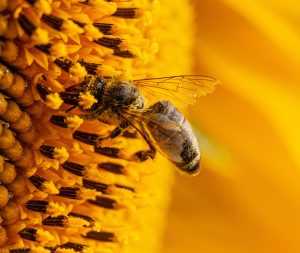How to grow sunflowers at home – A great addition to any garden
By Ken Johnson University of Illinois Extension Services — April 25, 2022
Sunflowers can be found in a variety of heights and colors. Gardeners need to select a variety based on their yard space. (Photo by Ken Johnson)
Sunflowers are a great addition to the home garden. Not only do they provide colorful flowers, but they can also be a potential food source for people and wildlife. With various shapes, sizes, and bloom colors, sunflowers are an easy plant to incorporate into your landscape.
Sunflowers are made up of ray and disc flowers. Orange sunflower showing ray and disc flowers.
Common misconceptions
Sunflower flowers aren’t actually a single flower. Rather they are a composite of smaller flowers. What we often think of as the petals of sunflowers are individual flowers, called ray flowers’ while the center of the flowers is made up of disc flowers. So, a single flower can be made up of hundreds of smaller flowers which makes them great plants for pollinators such as bees.
Another common misconception is that the flowers of sunflowers follow the sun (heliotropism). The smaller, immature flowers will track the sun during the day. At night the flowers will turn to face east again and repeat the cycle. As the flowers mature and open, though, their stems will stiffen, and the flowers will permanently face east.
Sunflowers facing east isn’t random either. Researchers with the University of California found east-facing sunflowers warmed up quicker than west-facing flowers, making them more attractive to pollinators. In fact, the east-facing flowers attracted five times as many pollinators compared to the west-facing flowers.
Choosing what to grow
When most people think of sunflowers, they think of large, tall plants that may not fit well into smaller landscapes. However, that isn’t always the case. Sunflowers can range in size from 6 inches to 12-plus feet tall.
If you are looking for smaller sunflowers, look for dwarf cultivars such as sunny bunch, sunray, and tiger eye that are less than three feet tall. Some cultivars, like Junior or Sunny Smile, may only get a foot or so tall and can be grown in pots!
If you want sunflowers that are a little taller, in the three to six-foot range, look at plants like Busy Bee, Fire Catcher, or Super Snack. If you want even taller sunflowers, look at Treasure Mountain (up to 10 feet), Kong (up to 14 feet), or Pikes Peak (up to 15 feet tall).

Sunflowers are a great food sources for pollinators like bees.
In addition to a wide variety of heights, the blooms of sunflowers can also be different colors. While we often think of sunflowers as yellow, orange, red, and purple blooming types can also be found. Additionally, certain types may only produce one flower, while others are branching and may produce dozens of flowers on a single plant.
Sunflower varieties
Sunflowers can be found in a variety of heights. A patch of sunflowers of various heights.
Sunflowers can be found in a variety of heights and colors
Sunflowers are fast-growing annual plants that do best in full sun. Sunflowers are able to grow in a wide variety of soils. So, as long as you have a sunny location and your soils aren’t consistently soggy, you can grow sunflowers.
Sunflowers are typically direct-seeded after the danger of frost has passed (early to mid-May). They can also be started indoors, typically two to three weeks before planting outdoors, if you want to get a head start. However, they don’t like having their roots disturbed, so be careful when transplanting. Sunflowers are also good candidates for succession planting (plant every 1-3 weeks), so you can have plants blooming for an extended period of time.
Larger varieties can be used as a living fence or as a backdrop for an ornamental bed. Smaller varieties can be incorporated into existing beds to provide color and to be cut for flower arrangements.
If you have kids or grandkids (or you’re just a big kid yourself), consider growing a sunflower house. Plant sunflowers in a square or circle at least 6-8 feet across (make sure to leave an entryway). Planting two staggered rows will make the walls denser. Before you know it, you’ll have a secret hideaway.
Caring for sunflowers
Sunflower headclipping weevil damage and beetle.
Sunflowers are relatively low-maintenance plants. While sunflowers are drought-tolerant, it is still a good idea to water them if the weather turns dry. Weeds can be a problem when plants are young. Weeds will compete with your sunflowers for light, water, and nutrients and can cause plants to become leggy and weak. Weeds can be managed by hand pulling, hoeing, or using mulches.







